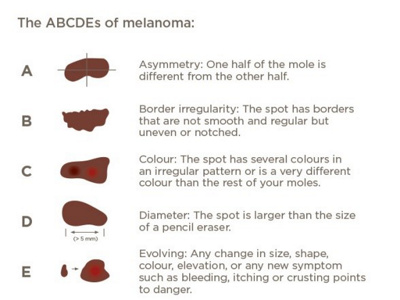There are many types of skin cancer but the most frequent types are basal cell carcinoma, squamous cell carcinoma and melanoma.
Melanoma is the most aggressive form of skin cancer. Because most melanomas occur on the skin where they can be seen, patients themselves are often the first to detect many melanomas. Early detection and diagnosis are crucial. Caught early, most melanomas can be cured with relatively minor surgery. The likelihood that the melanoma will come back or spread depends on how deeply it has gone into the layers of the skin. For melanomas that come back or spread, treatments include chemotherapy and immunotherapy, or radiation therapy.
If you notice a spot that looks as though it is new or changing, have it checked by a doctor. When it comes to spots on the skin, it is always better to be safe than sorry.

Factors that raise your risk for melanoma include:
- Caucasian (white) ancestry
- Fair skin, light hair and light-coloured eyes
- A history of intense, intermittent sun exposure, especially in childhood
- Many (more than 100) moles
- Large, irregular moles
- Close blood relatives - parents, siblings and children with melanoma
Slow daily sun exposure, even without burning, may also substantially raise your risk of skin cancer. The best way to know your risk level is to have a dermatologist perform a full body examination.
What methods are available to help prevent melanoma?
Reducing sun exposure: Avoiding sun exposure is the best means of helping to prevent melanoma, followed by wearing hats and tightly woven clothing, followed by broad-spectrum waterproof sunscreens applied liberally and often.
Early detection: Get your skin checked at least once. Then, if it is recommended, have your skin checked on a regular basis.
Screening of high-risk individuals: Anyone at high risk, such as those with a close relative who has melanoma, should be screened by a doctor.

